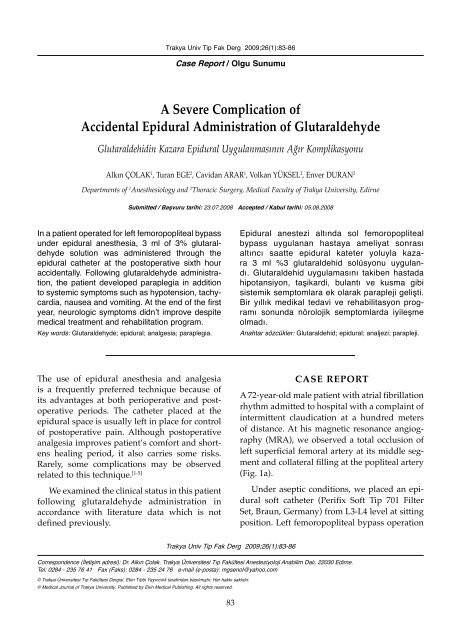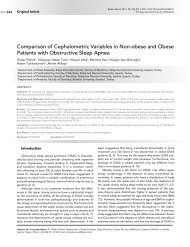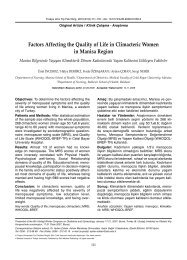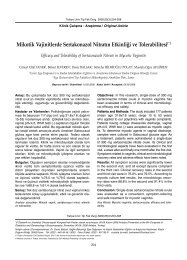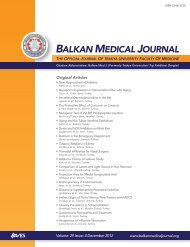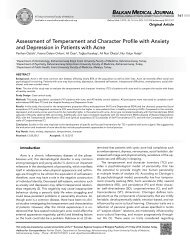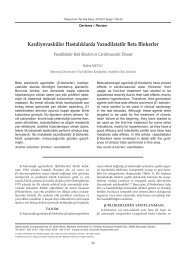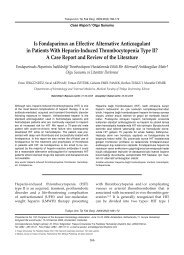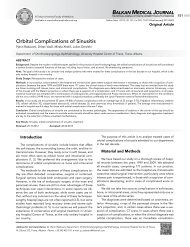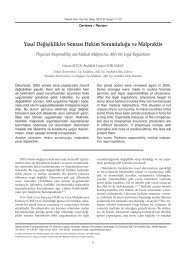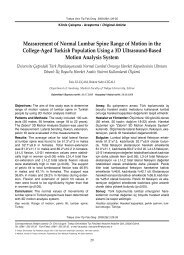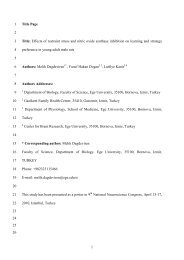A Severe Complication of Accidental Epidural Administration of ...
A Severe Complication of Accidental Epidural Administration of ...
A Severe Complication of Accidental Epidural Administration of ...
You also want an ePaper? Increase the reach of your titles
YUMPU automatically turns print PDFs into web optimized ePapers that Google loves.
Trakya Univ Tip Fak Derg 2009;26(1):83-86<br />
Case Report / Olgu Sunumu<br />
A <strong>Severe</strong> <strong>Complication</strong> <strong>of</strong><br />
<strong>Accidental</strong> <strong>Epidural</strong> <strong>Administration</strong> <strong>of</strong> Glutaraldehyde<br />
Glutaraldehidin Kazara <strong>Epidural</strong> Uygulanmasının Ağır Komplikasyonu<br />
Alkın ÇOLAK 1 , Turan EGE 2 , Cavidan ARAR 1 , Volkan YÜKSEL 2 , Enver DURAN 2<br />
Departments <strong>of</strong> 1 Anesthesiology and 2 Thoracic Surgery, Medical Faculty <strong>of</strong> Trakya University, Edirne<br />
Submitted / Başvuru tarihi: 23.07.2008 Accepted / Kabul tarihi: 05.08.2008<br />
In a patient operated for left femoropopliteal bypass<br />
under epidural anesthesia, 3 ml <strong>of</strong> 3% glutaraldehyde<br />
solution was administered through the<br />
epidural catheter at the postoperative sixth hour<br />
accidentally. Following glutaraldehyde administration,<br />
the patient developed paraplegia in addition<br />
to systemic symptoms such as hypotension, tachycardia,<br />
nausea and vomiting. At the end <strong>of</strong> the first<br />
year, neurologic symptoms didn’t improve despite<br />
medical treatment and rehabilitation program.<br />
Key words: Glutaraldehyde; epidural; analgesia; paraplegia.<br />
<strong>Epidural</strong> anestezi altında sol femoropopliteal<br />
bypass uygulanan hastaya ameliyat sonrası<br />
altıncı saatte epidural kateter yoluyla kazara<br />
3 ml %3 glutaraldehid solüsyonu uygulandı.<br />
Glutaraldehid uygulamasını takiben hastada<br />
hipotansiyon, taşikardi, bulantı ve kusma gibi<br />
sistemik semptomlara ek olarak parapleji gelişti.<br />
Bir yıllık medikal tedavi ve rehabilitasyon programı<br />
sonunda nörolojik semptomlarda iyileşme<br />
olmadı.<br />
Anahtar sözcükler: Glutaraldehid; epidural; analjezi; parapleji.<br />
The use <strong>of</strong> epidural anesthesia and analgesia<br />
is a frequently preferred technique because <strong>of</strong><br />
its advantages at both perioperative and postoperative<br />
periods. The catheter placed at the<br />
epidural space is usually left in place for control<br />
<strong>of</strong> postoperative pain. Although postoperative<br />
analgesia improves patient’s comfort and shortens<br />
healing period, it also carries some risks.<br />
Rarely, some complications may be observed<br />
related to this technique. [1-5]<br />
We examined the clinical status in this patient<br />
following glutaraldehyde administration in<br />
accordance with literature data which is not<br />
defined previously.<br />
CASE REPORT<br />
A 72-year-old male patient with atrial fibrillation<br />
rhythm admitted to hospital with a complaint <strong>of</strong><br />
intermittent claudication at a hundred meters<br />
<strong>of</strong> distance. At his magnetic resonance angiography<br />
(MRA), we observed a total occlusion <strong>of</strong><br />
left superficial femoral artery at its middle segment<br />
and collateral filling at the popliteal artery<br />
(Fig. 1a).<br />
Under aseptic conditions, we placed an epidural<br />
s<strong>of</strong>t catheter (Perifix S<strong>of</strong>t Tip 701 Filter<br />
Set, Braun, Germany) from L3-L4 level at sitting<br />
position. Left femoropopliteal bypass operation<br />
Trakya Univ Tip Fak Derg 2009;26(1):83-86<br />
Correspondence (İletişim adresi): Dr. Alkın Çolak. Trakya Üniversitesi Tıp Fakültesi Anesteziyoloji Anabilim Dalı, 22030 Edirne.<br />
Tel: 0284 - 235 76 41 Fax (Faks): 0284 - 235 24 76 e-mail (e-posta): mgsenol@yahoo.com<br />
© Trakya Üniversitesi Tıp Fakültesi Dergisi. Ekin Tıbbi Yayıncılık tarafından basılmıştır. Her hakkı saklıdır.<br />
© Medical Journal <strong>of</strong> Trakya University. Published by Ekin Medical Publishing. All rights reserved.<br />
83
A <strong>Severe</strong> <strong>Complication</strong> <strong>of</strong> <strong>Accidental</strong> <strong>Epidural</strong> <strong>Administration</strong> <strong>of</strong> Glutaraldehyde<br />
was performed with 8-mm full ringed polytetraflouroethylene<br />
vascular graft (Goro-Tex Stretch<br />
Vascular Graft, Arizona, USA) under epidural<br />
anesthesia maintained by 20 ml bupivacaine<br />
(Marcaine %0.5 flacon, AstraZeneca, Istanbul,<br />
Turkey) performed through this catheter. The<br />
epidural catheter was left in place for postoperative<br />
analgesia. At the postoperative sixth<br />
hour, we administered 3 ml bupivacaine + 3 ml<br />
serum physiologic from the epidural catheter<br />
for the relief <strong>of</strong> postoperative pain. Ten minutes<br />
after drug administration, the patient developed<br />
sudden hypotension, tachycardia, nausea,<br />
vomiting and cold sweating. After examining<br />
the last drug administration with details, we<br />
realized that the drug in the bupivacaine flacon<br />
was emptied and it was filled with 3% glutaraldehyde<br />
solution. We found out that 3% glutaraldehyde<br />
solution was administered instead <strong>of</strong><br />
bupivacaine from the epidural catheter. The first<br />
neurologic examination revealed that the muscle<br />
tonus at right thigh flexor group was 2/5,<br />
and at the remaining 1/5. The patient had left<br />
lower extremity plegia and hypoesthesia starting<br />
from L1 dermatome. There were no patellar<br />
or Achilles reflexes and Babinski sign was negative<br />
on both lower extremities. Perineal sensory,<br />
anal tonus, anal reflex, bulbocavernous reflex<br />
and cremasteric reflexes were lost. Abdominal<br />
skin reflex was present. We started 16 mg/day<br />
dexamethasone intravenously in addition to<br />
other supportive treatment.<br />
We observed disc bulge at dural sac at L4-L5<br />
level and hypertrophy <strong>of</strong> flaval ligaments at<br />
lumbar magnetic resonance myelography examination<br />
(Fig. 1b).<br />
We couldn’t get any response at sensorial<br />
evoked potential (SEP) records from the right<br />
and left tibial malleoli at electromyelographic<br />
(EMG) examination. Doppler ultrasonography<br />
showed that the left femoropopliteal bypass<br />
graft was patent.<br />
The patient was immediately taken into early<br />
rehabilitation program. By the end <strong>of</strong> one-year<br />
rehabilitation program, control EMG showed no<br />
records at both sural, tibial and peroneal nerves.<br />
At both lower extremities, L3-L4-L5 and S1 sensory<br />
and motor functions were evaluated as 0/5.<br />
There were no deep tendon reflexes, Babinski<br />
(a)<br />
(b)<br />
Fig. 1.<br />
(a) Preoperative angiographic image <strong>of</strong> the<br />
patient. (b) Lumbar magnetic resonance<br />
myelography image after epidural glutaraldehyde<br />
administration.<br />
84
A <strong>Severe</strong> <strong>Complication</strong> <strong>of</strong> <strong>Accidental</strong> <strong>Epidural</strong> <strong>Administration</strong> <strong>of</strong> Glutaraldehyde<br />
sign was bilaterally positive. There was no anal<br />
tonus and anal reflex.<br />
DISCUSSION<br />
<strong>Epidural</strong> anesthesia and analgesia serve important<br />
advantages in peripheric arterial vascular<br />
surgery by enhancing arterial and venous blood<br />
flow at the extremity due to administration<br />
<strong>of</strong> local anesthetic drugs performed through<br />
this catheter. The efficacy <strong>of</strong> epidural analgesia<br />
in reducing postoperative pain, response<br />
against stress, pulmonary and cardiac complications<br />
are the main reasons for preferring this<br />
technique. [1,3-5] We also preferred epidural anesthesia<br />
in this high cardiac risk patient in order to<br />
avoid complications <strong>of</strong> general anesthesia.<br />
Serious complications after epidural analgesia<br />
may be due to misplacement <strong>of</strong> the catheter<br />
or needle, infection, anaphylactic reactions,<br />
space-occupying lesion or direct needle<br />
trauma. [2,3,5,6] We couldn’t find any literature data<br />
as in our case even in rare complications <strong>of</strong> epidural<br />
anesthesia. In our case, we completed left<br />
femoropopliteal bypass operation without any<br />
complications under epidural anesthesia, but<br />
glutaraldehyde was accidentally administered<br />
in order to relieve postoperative pain.<br />
Glutaraldehyde may be used in cardiac surgery<br />
for preparation <strong>of</strong> cardiac valve prosthesis<br />
or pericardial patch under control. [7,8] As already<br />
known, 2% glutaraldehyde solution may be<br />
used for disinfection and sterilization against<br />
viruses and bacteria. Also 3-6% solutions <strong>of</strong><br />
glutaraldehyde is used for fixation <strong>of</strong> tissue<br />
samples for electron microscopic examination.<br />
Glutaraldehyde may cause ophthalmic, skin and<br />
pulmonary system irritation in laboratory workers.<br />
Also glutaraldehyde used in sterilization <strong>of</strong><br />
endoscopic materials may cause serious necrosis<br />
if not removed from the environment totally. [9]<br />
In our patient, ten minutes after glutaraldehyde<br />
administration through the epidural space,<br />
the patient developed systemic symptoms as<br />
hypotension, tachycardia, nausea, vomiting and<br />
cold sweating. These symptoms continued for<br />
around one hour and disappeared with supportive<br />
treatment. Kietzmann et al. [10] reported that<br />
85<br />
drugs administered from epidural catheter reach<br />
their maximum plasma concentration in ten<br />
minutes. We thought that the systemic effects<br />
ten minutes after glutaraldehyde administration<br />
may be due to passage into systemic circulation<br />
via diffuse venous structures in the epidural<br />
space.<br />
The chemical detrimental effect <strong>of</strong> glutaraldehyde<br />
starts in few minutes especially on proteins.<br />
The injury after glutaraldehyde administration<br />
will be great since it has no antidote and<br />
early surgery doesn’t improve the neurologic<br />
status. Since the drug administered from the<br />
epidural catheter can neither be aspirated back<br />
nor neutralized, glutaraldehyde already fixed all<br />
neural tissue at the lumbar region and resulted<br />
in that clinical status.<br />
As a result <strong>of</strong> local effect at the epidural<br />
space, irreversible nerve injury had occurred<br />
under L3 level. We didn’t observe a neurologic<br />
healing in one-year follow-up compared to early<br />
neurologic findings. We already thought that<br />
expecting the healing <strong>of</strong> neural damage caused<br />
by a strongly irritating drug like glutaraldehyde<br />
is a highly optimistic idea.<br />
The sensory and motor functions didn’t<br />
improve after one-year rehabilitation program<br />
in this clinical status resulted from a very serious<br />
mistake. Rehabilitation program only helped<br />
progression in the ability to use the wheelchair<br />
by strengthening the upper extremity muscles.<br />
In conclusion, glutaraldehyde administration<br />
through epidural space has both local and systemic<br />
effects. Systemic effects may be controlled<br />
by supportive treatment, and also early rehabilitation<br />
program may be beneficial because <strong>of</strong> the<br />
permanent neural damage. Another important<br />
issue is to remind that chemicals other than<br />
drugs must be kept away from drug fridges.<br />
REFERENCES<br />
1. Wu CL, Thomsen RW. Effect <strong>of</strong> postoperative epidural<br />
analgesia on patient outcomes. Techniques<br />
in Regional Anesthesia and Pain Management<br />
2003;7:140-7.<br />
2. Ballantyne JC, McKenna JM, Ryder E. <strong>Epidural</strong><br />
analgesia-experience <strong>of</strong> 5628 patients in a large<br />
teaching hospital derived through audit. Acute Pain
A <strong>Severe</strong> <strong>Complication</strong> <strong>of</strong> <strong>Accidental</strong> <strong>Epidural</strong> <strong>Administration</strong> <strong>of</strong> Glutaraldehyde<br />
2003;4:89-97.<br />
3. Moore JM. <strong>Epidural</strong> analgesia and clinical outcomes.<br />
Seminars in Anesthesia, Perioperative Medicine and<br />
Pain 2003;22:197-208.<br />
4. Haetzman M, Stickle B. <strong>Epidural</strong> analgesia for postoperative<br />
pain. Current Anaesthesia and Critical<br />
Care 1999;10:140-6.<br />
5. Horlocker TT, Wedel DJ. Neurologic complications<br />
<strong>of</strong> spinal and epidural anesthesia. Reg Anesth Pain<br />
Med 2000;25:83-98.<br />
6. Albright GA, Forster RM. The safety and efficacy <strong>of</strong><br />
combined spinal and epidural analgesia/anesthesia<br />
(6,002 blocks) in a community hospital. Reg Anesth<br />
Pain Med 1999;24:117-25.<br />
7. Rieder E, Seebacher G, Kasimir MT, Eichmair E,<br />
Winter B, Dekan B, et al. Tissue engineering <strong>of</strong> heart<br />
valves: decellularized porcine and human valve<br />
scaffolds differ importantly in residual potential to<br />
attract monocytic cells. Circulation 2005;111:2792-7.<br />
8. Kim SS, Lim SH, Cho SW, Gwak SJ, Hong YS, Chang<br />
BC, et al. Tissue engineering <strong>of</strong> heart valves by recellularization<br />
<strong>of</strong> glutaraldehyde-fixed porcine valves<br />
using bone marrow-derived cells. Exp Mol Med<br />
2006;38:273-83.<br />
9. Karpelowsky JS, Maske CP, Sinclair-Smith C, Rode<br />
H. Glutaraldehyde-induced bowel injury after laparoscopy.<br />
J Pediatr Surg 2006;41:23-5.<br />
10. Kietzmann D, Foth H, Geng WP, Rathgeber J,<br />
Gundert-Remy U, Kettler D. Transpulmonary disposition<br />
<strong>of</strong> prilocaine, mepivacaine, and bupivacaine in<br />
humans in the course <strong>of</strong> epidural anaesthesia. Acta<br />
Anaesthesiol Scand 1995;39:885-90.<br />
86


